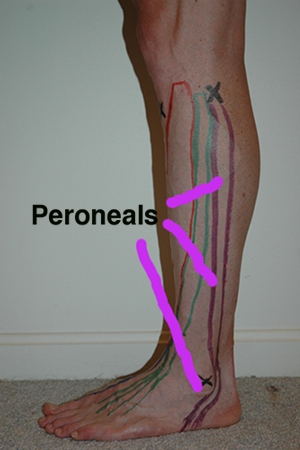Peroneals
As you may recall from our intro post on kinesiology taping, we’re going to focus on each muscle group/joint and show you how to use kinesiology tape in three distinct ways:
1. Immediately after injury (for swelling and pain)
2. During the healing process (correction techniques to restore normal position and allow for healing)
3. Techniques to help improve strength + function
In this post, we’ re going to be talking about taping techniques that are trying to decrease the activity of the peroneal muscles (there are two- the longus and brevis). This is perfect for recovering muscles where you want to provide support and allow for rest so that the injured muscle/tendon can heal.
This type of application is called an inhibition technique. The key for using it is to use the anatomy! Remember, the tape is specifically made to pull on itself. That is what the weird spirals and shapes are when you look a the back of the tape. When trying to inhibit the muscle, you want the tape to move from the muscle insertion to origin so that when the tape pull on itself, it results in an eccentric pull (eccentric = lengthening of the muscle). This is ideal for trying to diminish the contraction which will allow for rest and more importantly recovery.
Anatomy
I’m going to bunch these two muscles together since they are both responsible for the same motion and follow the same pathway; the brevis is just shorter. Both muscles are responsible for everting the foot (tilting the foot out away from the body; just the foot moves, not the entire leg). The long muscle runs from the fibular head, down the outside of the leg, behind the lateral malleolus and wraps under the foot just before heel. The short muscle starts midway down the fibula and follows the same path. You can read more about the anatomy and surrounding muscles here.
What you will need:
1) Roll of kinesiology tape
2) Sharpest scissors in the house.
Prep work:
1) Clean skin. This means no oils or lotions of any kind. You want your skin to be clean and more importantly dry. Moisture of any kind = tape will fall off or fail to stick altogether.
2) Hair care. Ideally, the less hair the better. Guys, this means that for best results you will need to trim any long leg hair or shave the calf area.
3) If clean, dry, and hairless skin still = no sticking of tape. Time to get some adhesive spray like Tuf Skin.
4) The tape should last 3-5 days. You can get it wet and shower with it on. Just towel dry it after. No hair dryer! The tape is heat activated.
Taping Techniques
1) Inhibition technique for the peroneals
Key Points:
- Prep the skin first. For this application you will want to put the foot and ankle on stretch (point the toes down and in; this is similar to the position your foot would be in if you caught the outer edge of your foot and rolled your ankle).
- There will be one strip for this application. It will be anchored midway down the outer edge of the foot. From here place the muscle in the stretch position and then lay the tape down along the path of the peroneals. Remember, the tape works by pulling on itself and you have already put the muscle on stretch to do the work for you. There is no need to stretch the tape out more.
- See the video above for full details.
- For further instructions on how to incorporate kinesiology taping into your self treatment regimen click here.
References
1) Capobianco, Dr. Steven and van den Dries, Greg. (2009). Power Taping, 2nd Edition, Rock Tape Inc, Los Gatos, CA.
2) Hammer, Warren. (2007). Functional Soft-Tissue Examination and Treatment by Manual Methods, 3rd edition. Jones and Bartlett Publishers, Inc, Sudbury, MA.
3) Kase, Kenzo, Wallis, Jim, and Kase, Tsuyoshi. (2003). Clinical Therapeutic Applications of the Kinesio Taping Method.
4) Muscolino, Joseph. (2009). The Muscle and Bone Palpation Manual. Mosby, Inc, St. Louis, MO.












